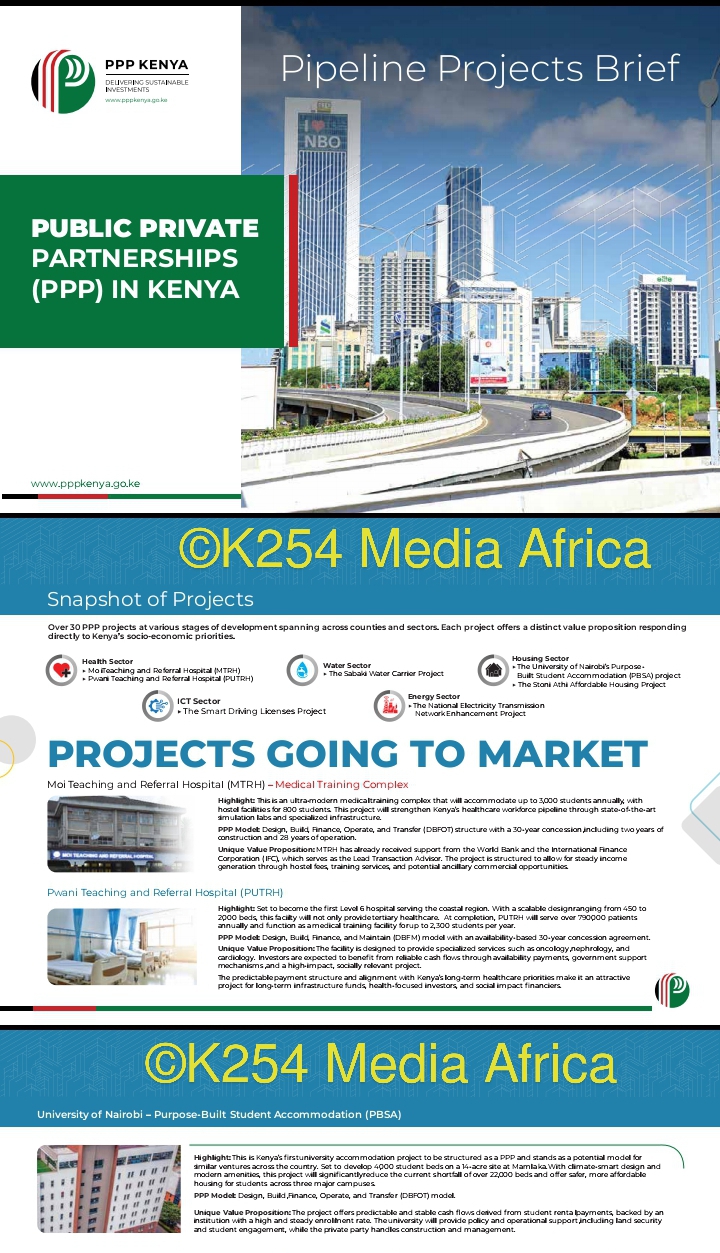Demystifying Negative Perception vs Facts about PPP Models – Public–Private Partnership in Kenya, Africa & Globally
By Muhoro Pius W.
Business & International Trade Editor | PPP Consultant – Africa & Global Markets
K254 Media Africa
1. Introduction
Public–Private Partnerships (PPPs) are collaborative frameworks between governments and private sector players designed to deliver public infrastructure and services efficiently. Globally, PPPs are anchored on the Build–Operate–Transfer (BOT) model, where private entities Design, Finance, and Construct Infrastructure, Operate it for a concession period (e.g. 25-30 or even 50 Years in relation to the Signed Agreement with a government)to recover their investment, and later transfer ownership to the government—representing the people.
Explaining word by Word In the BOT model:
B –for Build: The private partner designs and constructs the infrastructure (e.g., roads, dams, airports).
O –for Operate: The investor operates the project for a period (typically 20–50 years) to recoup investment and generate profit.
T –for Transfer: Ownership and management revert to the government, ensuring sustainability and continuity of public benefit.
This structure ensures that citizens ultimately own the assets, while benefiting from world-class infrastructure financed and operated by the private sector.
2. Types of PPPs
PPPs can be broadly categorized into Direct and Indirect models:
A. Direct PPPs
These involve agreements directly between a private entity and the government for a specified concession period, often 30–50 years. For instance, a private company may construct and operate a toll (pay to use e.g .Nairobi Expressway) highway or energy plant, collecting user fees before transferring ownership to the state.
B. Indirect PPPs
These involve mechanisms such as levies or public funds channeled through development finance institutions (DFIs) or multilateral organizations like the IMF, World Bank, or African Development Bank (AfDB). For example, Kenya’s Railway Development Levy contributes to long-term concession repayments, showcasing how donor-supported PPPs function in hybrid financing ecosystems.
3. Benefits of Performing PPPs Unlike Debt Financing
PPPs offer a strategic alternative to traditional Debt-based financing. Unlike direct government borrowing, PPPs emphasize Performance, Accountability, and Efficiency.
1. Reduced Corruption and Improved Accountability: Private investors ensure project efficiency and oversight since profitability depends on delivery.
2. People-Centric Value Creation: Every coin matters because the project’s success is tied to private-sector investment and public satisfaction.
3. Fiscal Relief: PPPs free government budgets from upfront Capital burdens while ensuring infrastructure expansion.
ANNOUNCEMENT! Register early for the Africa Public–Private Partnership Summit by K254 Media Africa (June 24–27, 2026) to explore PPP investment opportunities across Africa…Here’s the Link for Delegates, Sponsors, Governments, ExhibitorsConcept Paper Contributors/Researchers/Academia/Experts and the Media/Journalists e.t.c.
4. Challenges Facing PPP Implementation – Case Study: Kenya
Kenya’s PPP landscape has seen both progress and friction. On June 25th,2025, youth-led protests against ‘opaque deals’ such as the canceled Adani–Kenya Airports Authority (KAA) & Adani KETRACO Power Transmission Lines takeover exposed the need for Transparency and civic education.
Key challenges include:
1. Lack of public awareness and engagement on PPP models.-herein Civic Education on how PPPs Work & Transparency.
2. Misconception of PPPs as privatization.
3. Political interference and weak institutional capacity.
4. Inadequate feasibility studies and poor risk-sharing mechanisms.

